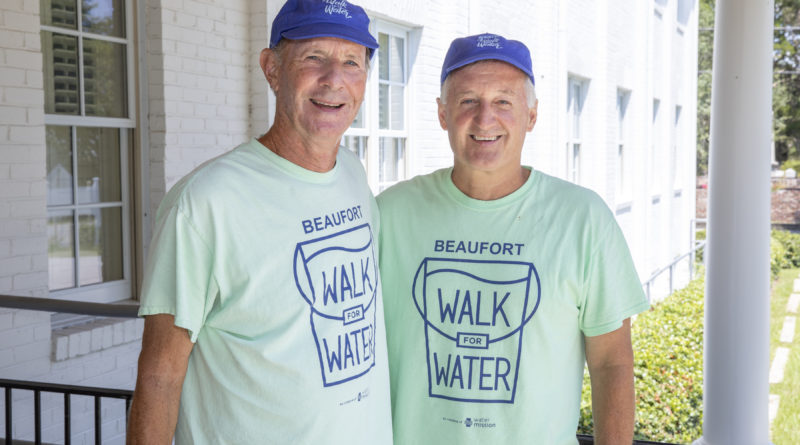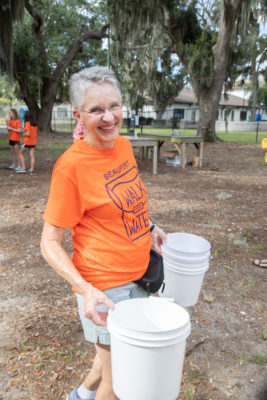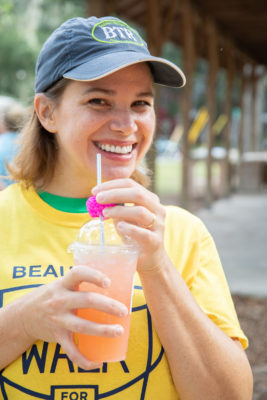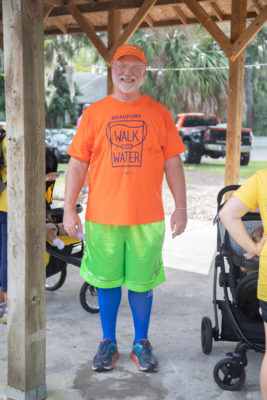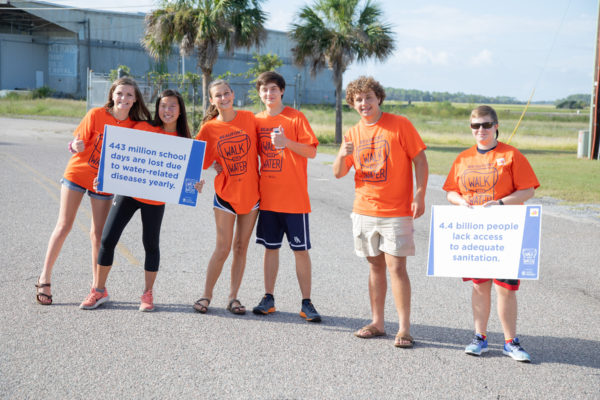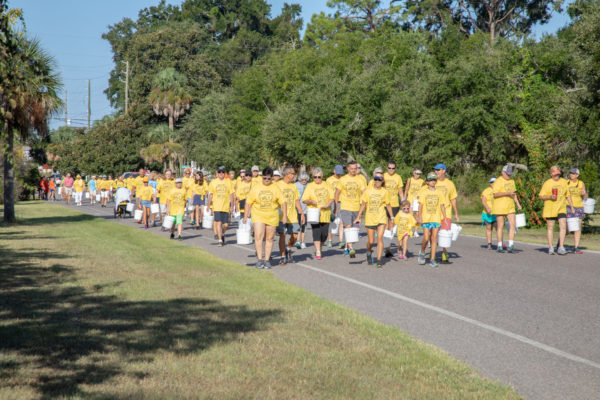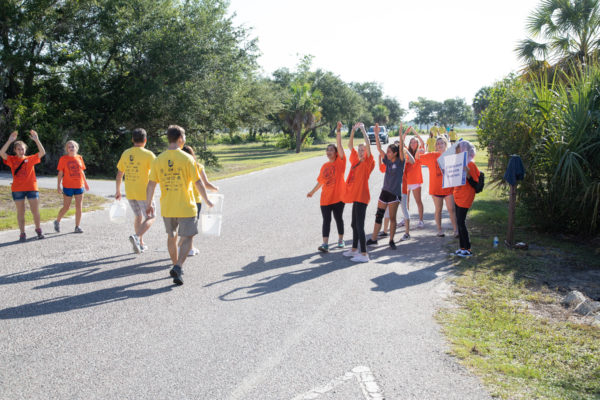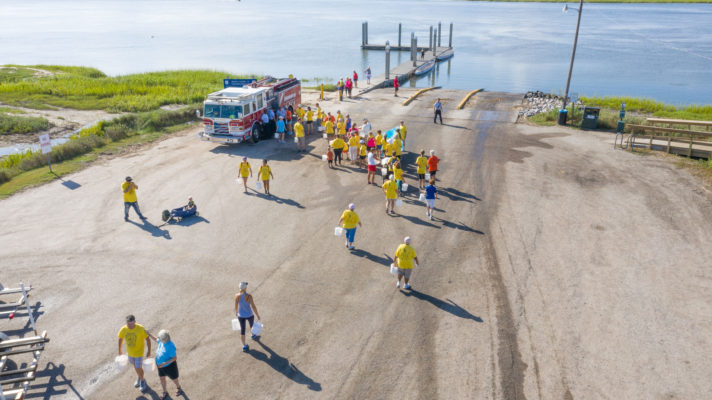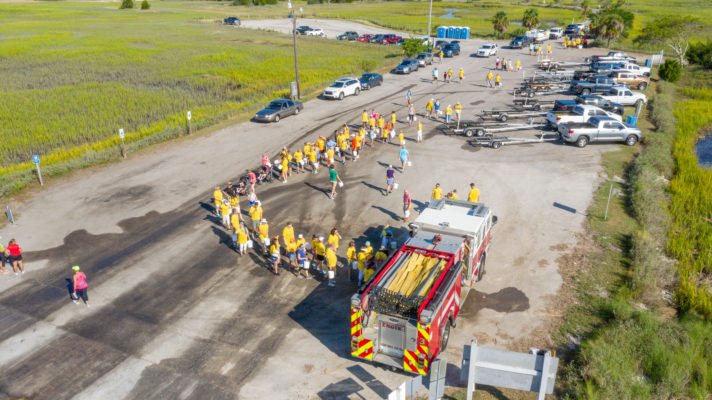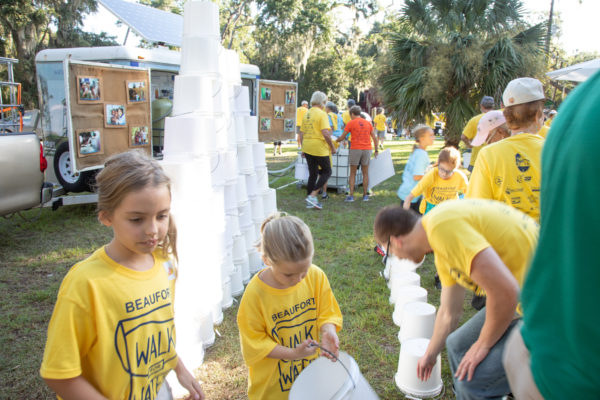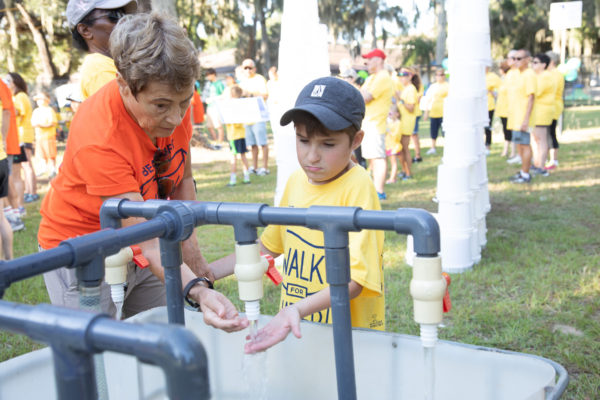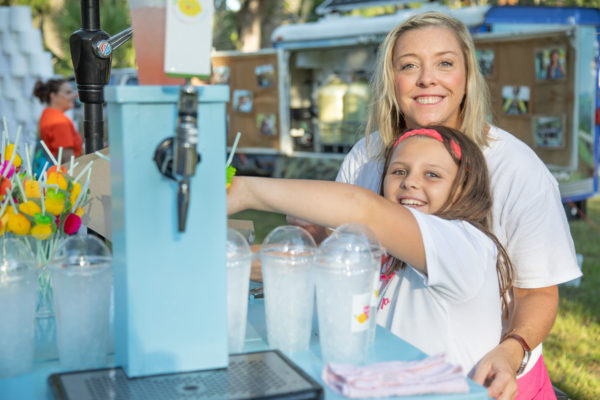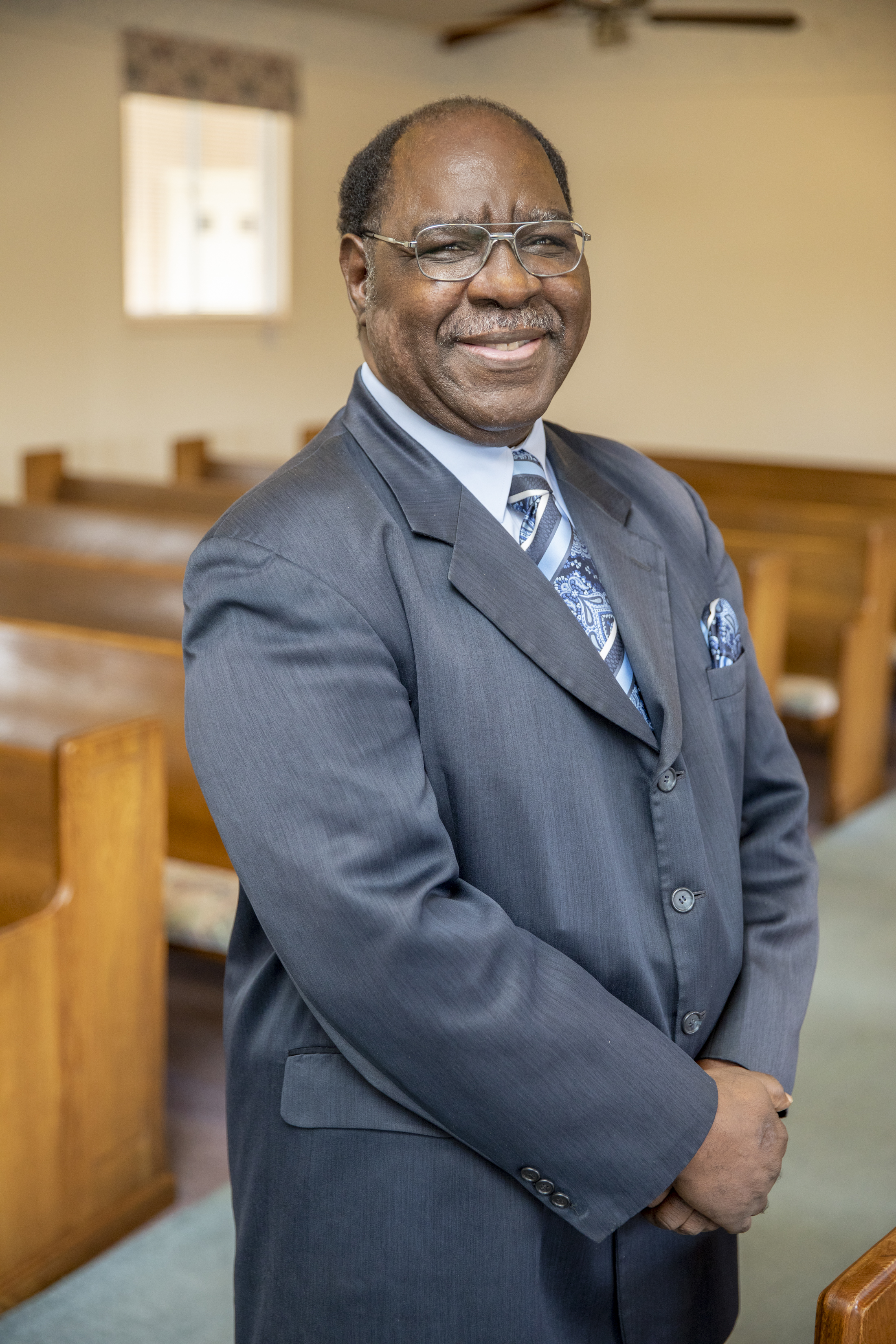Jim Pickard and Robert Lasher
CO-CHAIRS OF THE 3RD ANNUAL BEAUFORT WATER WALK
WE WALK SO OTHERS WON’T HAVE TO
story by LINDSEY LENOIR photos by PAUL NURNBERG
Let me paint a picture for you. Imagine, for a moment, that you are a Honduran woman. In your village, the closest water source is a river the color of mud, about a mile and a half away. It is not only your sole source of water, it is also a watering hole for everyone else in your village, people and animals alike. It’s unsanitary and disease-filled, but it’s all you have to cook with, bathe with, and drink. Every day of your life, you make the trek back and forth, carrying buckets, pots, whatever you can fill to provide for your family for the day. Every day you walk, rain or shine, in sickness or health, you walk. Your prize for all of this hard work? Dirty, filthy, water that is unfiltered, unpurified, and unsafe for you and your family. It will most likely make you and your children sick, but you have no choice, it’s all you have, and your life revolves around it. This is a harsh existence, but a daily hardship that an estimated 1.8 billion women and children face globally.
On October 29, 1998, Hurricane Mitch made landfall on the coast of Honduras. It was the strongest hurricane of the season and had just weakened from a category five when it pummeled the small islands and villages along the coast of Honduras. The damage caused by the storm was said to have set the country back 50 years in economic development. Due to the terrible flooding, much of the country’s Caribbean coastline was devastated. All total, Honduras suffered a staggering $3 billion in damages. It was in the aftermath of this storm that the late Molly Green and her husband George, who operated an environmental engineering company, began receiving requests for multiple water treatment systems to help the people of Honduras. Unfortunately, there were no such systems to be found that would work on this scale. So, George and a team of engineers set to work and developed a system of their own. The Greene’s decided to venture to Honduras to get a first-hand account of the conditions and devastation the country was suffering and to see if their water purification system would indeed work. When they got there, they were stunned. In one village, there was a river running through that, according to the Greene’s was, “The color of chocolate milk…deep brown with toxins, bacteria, and hopelessness.” It was referred to by the residents as, “The River of Death.”
Soon, the Greene’s had a water purification system in place that was fully operational, but the villagers were afraid to drink the purified water. It wasn’t until Molly Greene drank from the water hose that the rest of the villagers followed suit. The situation in Honduras was just a small example of a much larger, global water crisis.
Millions of people in developing countries across the globe are forced to drink water that isn’t safe for human consumption. In 2001, the Greenes founded the Christian engineering nonprofit, “Water Mission International,” in an effort to aid in this devastating crisis. Water Mission’s goal was to, “implement safe water, sanitation, and hygiene solutions for people in developing countries and disaster areas.” Their solar powered, water purification systems were set to change the course of the water crisis. Water Missions developed the system, mapped out how to install them in different geographic locations, arranged delivery, and created an infrastructure of maintenance and education so that once installed villages could be self-sustained. The only obstacle left was the funding required to make all of this happen.
A large part of the success of Water Missions is due to the many volunteers and donors that are led to serve the global community. In 2015, a gentleman by the name of Kevin Herr, the Director of Church partnerships at Water Mission, came to the First Presbyterian Church of Beaufort and spoke to the congregation about the nonprofit. Jim Pickard just so happened to be attending that service and was inspired by what Kevin had to say. Until this point, Jim had little information about the water crisis and could not deny that after hearing Kevin speak, was moved to do something about it, “I knew I needed to help in some way.” The church arranged for a team to go and tour the Water Mission’s North Charleston facility, and Jim Pickard promptly volunteered. Jim recounts his experience, “I was amazed at all of the work the volunteers were doing and I knew that is where I wanted to be…hands on, assembling, so I started by putting together filters for the purifying systems.” In the beginning, Jim would make the 150-mile round-trip drive every week to volunteer at the North Charleston facility, “All of the systems are assembled by volunteers, so, on Thursdays, I would work and then attend a Mission lunch, they would feed us lunch every week.” It was during these lunches that Jim began to learn more about the main fundraising event, which is the Charleston Walk for Water. In 2016, Jim would join a group from his church, along with 4,000 other participants, for the Charleston Walk. “I thought, you know, we should have a walk in Beaufort…”
According to their website, the Water Mission estimates that with their system in place, it only costs $25 to provide someone with safe water for life. In addition to providing life-saving water, “The Mission also aids in building latrines to promote proper sanitation in villages and communities.” Since its inception in 2001, it has provided access to safe drinking water to over 4 million people in 55 countries.
“Many of the world’s deadliest diseases are transmitted through water. Cholera, typhoid, diarrhea…for children under the age of five, dirty water is a leading cause of death. Half of the hospital beds in the world are filled with people with water related illnesses.”
Robert Lasher began his journey with Water Mission as a donor. Today, he has been working with the nonprofit for almost 8 years in total. “Bob” and his wife moved to Beaufort in 2017. He moved just in time to be a part of Beaufort’s inaugural Walk for Water. “The Walk for Water had already been going on in Charleston as the Water Mission’s biggest fundraiser”. The more he began to learn about where his money was going, the more he felt compelled to be a part of the hands and feet of the mission. He began working on the fundraising team and donor team concurrently, while still living in Charleston. Robert remembers he and his family were attending Seacoast Church in Charleston. “The Greene’s were speaking and had set up a purification system in the lobby. Molly and George spoke about the infant mortality rate due to waterborne illnesses, and of the millions of people who don’t have clean drinking water.” Before that, Bob said, “Thinking about someone not being able to have clean water to drink wasn’t even on my radar. So many young children are dying of waterborne illnesses, and we have the answer, we know how to fix it, and we know how to deliver it to them, it’s just that we need to keep raising the funds and awareness.” Finally aware of what was happening, “I couldn’t turn my back and keep going on with my regular life. I would think about all of those women and children who have to go through so much, only to get dirty water that is unsafe for them. Here I am, sometimes not wanting to walk the few steps across the kitchen to pour a glass of clean, purified water for myself. It really changes your perspective.” He remembers George Greene saying, “The size of the problem is just unbelievable and the need to solve the problem is of utmost urgency,” and this simple statement sparked something in Robert. He knew he wanted to be a part of this solution.
After he moved to Beaufort, Bob would connect with Jim through their shared passion for Water Mission. Bringing the Walk for Water to Beaufort was initially something that Jim wanted to see happen. In 2017, that came to fruition with Beaufort’s inaugural Walk for Water.
Walk For Water
In an act of solidarity for the millions of women and children globally who walk more than 3 plus miles a day to get water, the Water Mission International Walk for Water raises awareness and funds to provide long term, self-sustaining water purification systems to developing countries who have no clean water sources. This year marks Beaufort’s 3rd annual Walk for Water. On September 21st, a projected 500 plus people, divided into teams, will gather together in Port Royal to support a cause that is bigger than they can fathom. Registration will begin at 8am, the walk starts by 9. Teams have until the day of the walk to sign up. The cost is $20 for adults, $10 for youth, age 6 and under are free. Participants will each grab a bucket provided and begin the mile and a half designated route through the streets of Port Royal. Walkers will end up at The Sands, where the Port Royal Fire Department will be there to fill the buckets with water. According to Jim, “They will fill the buckets as full as you want or feel comfortable carrying for the rest of the mile and a half walk.”
Robert Lasher and Jim Pickard are co-chairs for this year’s Walk. Robert is in charge of sponsorship and Jim heads up recruitment. Jim emphasizes, “My idea is to spread the net, to cast a larger net and not just harvest the church participants, but also our neighbors, co-workers, and fellow Beaufortonians.” These two men, along with many others, are passionate about this mission and are looking forward to the projected 400 walkers slated to come September 21st. Their goal: to raise $50,000. Last October, Jim was able to take a mission trip to Haiti with Water Mission. While there, the group visited a small Haitian village called Figuier. Jim tells of how they were greeted by, “a dozen or so children, accompanied by the villages Water Systems Director.” The Director thanked the group many times over and went on to tell of how healthy the children in the village were, that they no longer lived in fear of getting cholera. Jim also gave a testimony about a hospital in Grand Passe, Haiti, “When we arrived in Grand Passe, we were taken to the local hospital. We were astounded by the fact that the hospital didn’t have clean water. Can you imagine, a hospital using dirty water?” The group immediately inquired of Water Mission concerning the allocation of funds raised by the 2018 Walk for Water, “We wanted to know if we could allocate 100% of the funds raised at the 2018 Beaufort Walk to providing a purification system to the people of Grand Passe and the hospital. They said, ‘of course!’ I am happy to say, the 2018 Beaufort Walk for Water fully funded the project in Grand Passe and the hospital there now has clean water.”
Water is a basic resource that, here in the United States, is taken for granted. Could you even imagine what it would be like to, day after day, put a glass of murky, muddy, bacteria-filled water to your lips to drink, passing that same glass to your children? It’s a reality that most of us never pause to think about, even though it’s one of the biggest global crisis’ to date. The first step to taking action is awareness, and that is what the 3rd Annual Beaufort Walk for Water is providing, awareness. Now that you know, show up on September 21 stand support this life-changing mission. If you can’t make it, you can also go online and donate. Bob puts it like this, “This is one of the most fulfilling things that I have ever been a part of. One of the most rewarding aspects about it is the fact that it has really turned into a fun, community event. Everyone comes together to gains an understanding of what it’s like for these people, but they are there with friends, and kids, and pets. A community of people coming together to make a difference in these people’s lives forevermore.”
For more information about the Beaufort Walk for Water and Water Missions, or to donate visit events.watermissions.org/beaufort19

